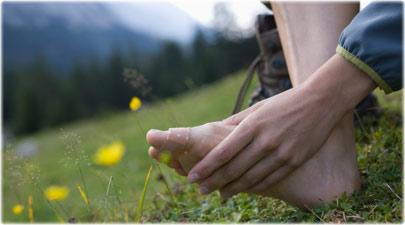article from foothealthfacts.org
Lack of preparation and insufficient gear may increase risk for pain and injury. 
In the United States, more than 38 million people annually go hiking, and the popular recreational activity has recently seen increased interest in its more competitive and extreme forms. The American College of Foot and Ankle Surgeons (ACFAS) reminds all hikers, whether avid or recreational, that injuries are common and careful planning is essential to reducing the likelihood of injury and complications when they occur.
"We've all seen hikers accomplishing great feats, such as completing the Pacific Crest or Appalachian Trails, and these stories inspire us to undertake more challenging or longer hikes," says Gregory Catalano, DPM, FACFAS, a Massachusetts-based foot and ankle surgeon and Fellow Member of the American College of Foot and Ankle Surgeons. "As the number of people hiking increases and they take on more challenging terrain, we are seeing an increase in injuries of all levels of hikers, from Achilles tendon and heel pain to more traumatic injuries, including sprains and fractures of the foot and ankle as well as stress fractures of the leg, foot and ankle."
Hiking-related injuries range from minor concerns, such as blisters and bruises, to more serious conditions, including stress fractures and ankle sprains. These complex hiking injuries may initially be assessed as less serious or even overlooked as an overuse injury that will repair itself. Some hikers first attempt to treat pain by modifying their walk (gait) or pace or by switching shoes. While these kinds of modifications seem straightforward, they can actually contribute to complications and further injury.
"It is critical that hikers know the signs and continually monitor for complex injuries, as not seeking treatment may result in additional damage that can lead to longer, more involved treatments and recovery periods," continues Dr. Catalano.
Careful preparation can help reduce the likelihood of injury and make it easier for professionals to treat when problems occur. ACFAS advises hikers that a few key steps can make an important difference:
- Protect toes from blisters and toenails from bruises by wearing proper-fitting footwear.
- Select material for socks that wick away moisture and protect from the cold.
- Condition boots before setting out on a hike.
- Know the hiking route and options for accessing medical assistance.
Carry supplies, such as bandages and wraps, to help immediately protect and stabilize injured feet and ankles.
